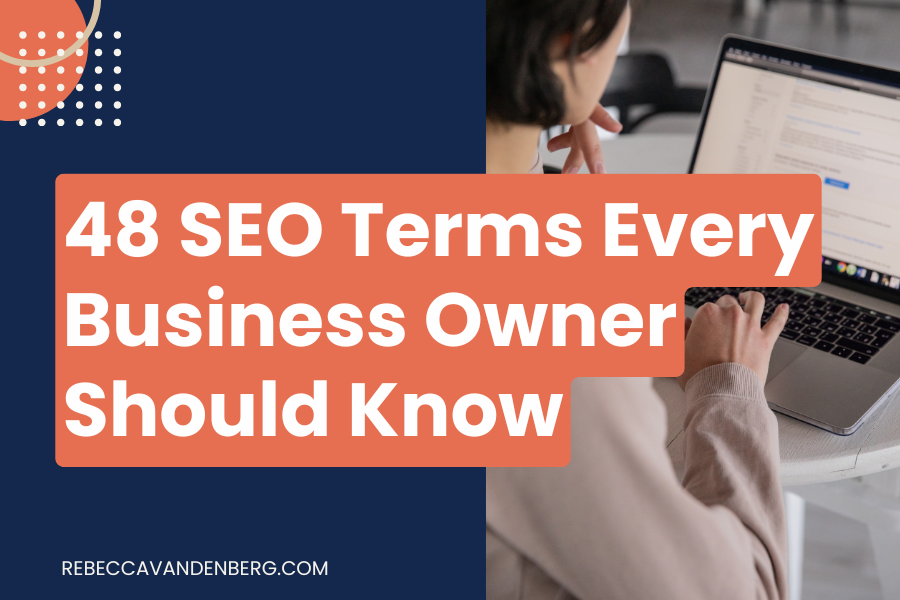Navigating the world of SEO can be overwhelming to many business owners. As a website consultant, it’s my job to help explain what terms mean and how they impact a client’s website. And ultimately how they help bring in more business.
Understanding these terms is the first step to understanding how SEO can improve and help a business build their business online. The next step is understanding how clients search for your business services. When you can align your SEO activities to show up where they search, that’s where the magic happens!

Business Owners Who Invest in Learning Marketing See Revenue Growth
“Small businesses that invest in marketing education see an average of 20% higher revenue within 12 months compared to those that don’t.”
— U.S. Small Business Administration (SBA) Learning Impact Study
SEO Terms
SEO Audit
Complete check-up of your website’s search performance.
Ranking
The position your page appears in search results.
Traffic
Visitors who land on your site.
Crawling
Search engines scanning to see what’s on your site.
Indexing
Storing your pages in Google’s library to show in results.
Backlink
A link on another site that directs to your site.
Sitemap
A file that lists all your site’s pages for search engines to crawl.
Alt Text
Text that describes an image to search engines and users.
Meta Title
Clickable title of your page shown in Google results.
Anchor Text
The clickable text of a link.
Search Volume
The number of times a keyword is searched in a month.
Domain Authority (DA)
A score predicting how likely your site is to rank in search engines.
Page Authority (PA)
How strong a single page is on your site in ranking potential.
Meta Description
Short description shown under your title in search results.
Keyword Stuffing
Using the same keyword too many times in your content to improve ranking.
Duplicate Content
When two or more pages have the same content.
Linking
Links between pages on the same site or to external sites.
Click-Through Rate (CTR)
The percentage of people who click the link after seeing it in search results.
Bounce Rate
The percentage of visitors who leave your site after viewing only one page.
Dwell Time
How long someone stays on your site before going back to search results.
Search Intent
What the user is really searching for when they’re searching.
Long-Tail Keyword
A longer, more specific keyword or phrase.
E.g., “best SEO tools for freelancers”
Content Cluster
A group of related content around one topic.
Featured Snippet
Highlighted answer Google shows above all results.
Schema Markup
Code that helps search engines understand content better.
SEO Plugin
Tool that helps optimize your content (e.g., Yoast).
Page Speed
How fast your page loads on desktop or mobile.
Core Web Vitals
Google’s metrics for measuring site experience, such as speed, stability, and interactivity.
Mobile-First Indexing
Google uses mobile performance to rank your site.
Keyword Cannibalization
When you use multiple pages to rank for the same keyword.
301 Redirect
Permanently sends users and search engines to a new page.
404 Error
A page that no longer exists or can’t be found.
Link Juice
SEO value passed down from one page or website to another via links.
Latent Semantic Indexing (LSI)
Keywords related to your main keyword that help content rank better.
Evergreen Content
Content that stays relevant and useful over time.
Disavow File
Used to tell Google to ignore spammy backlinks.
Keyword Density
How often a keyword appears on a page compared to total words.
Local SEO
Optimizing to appear in local search results (e.g., “near me”).
Black Hat SEO
Sneaky tactics to rank faster.
White Hat SEO
Ethical strategies that follow Google’s rules.
AI Overviews
Google’s AI-generated summaries that appear at the top of some search results, providing quick answers without needing to click a link.
LLM (Large Language Model)
A type of AI trained on vast text data to understand and generate human-like language, increasingly powering search results and content tools.
GEO (Generative Engine Optimization)
The practice of optimizing content specifically to appear in AI-generated answers (e.g., Google’s AI Overviews or ChatGPT responses).
E-E-A-T (Experience, Expertise, Authoritativeness, Trustworthiness)
Google’s quality criteria used to evaluate the credibility and value of content, especially for YMYL (Your Money or Your Life) topics.
Zero-Click Search
A search where users find the answer directly in the results (e.g., AI summary or featured snippet) and don’t click through to a website.
Topical Authority
How well your site covers a specific subject area, which can boost ranking in niche searches when content is comprehensive and interconnected.
First-Party Data
User data collected directly from your website (e.g., via forms, analytics) that is becoming more important as third-party cookies phase out.
Helpful Content Update
Google’s algorithm change focused on rewarding content that is useful, original, and written for humans—not just to rank in search engines.
Businesses that Prioritize SEO Grow Faster
“Companies that prioritize SEO are 13 times more likely to see positive ROI than those that don’t.”
— HubSpot’s State of Marketing Report
Ready to turn SEO jargon into real results?
Let’s put these terms to work for your business with a strategy that gets you found by the right customers—right where they’re searching.
Book your free website & SEO consultation today and start climbing those search rankings with confidence.
